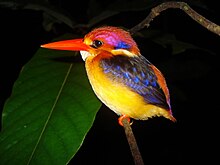
Kingfishers are a family, the Alcedinidae, of small to medium-sized, brightly coloured birds in the order Coraciiformes. They have a cosmopolitan distribution, with most species living in the tropical regions of Africa, Asia, and Oceania, but also can be seen in Europe. They can be found in deep forests near calm ponds and small rivers. The family contains 116 species and is divided into three subfamilies and 19 genera. All kingfishers have large heads, long, sharp, pointed bills, short legs, and stubby tails. Most species have bright plumage with only small differences between the sexes. Most species are tropical in distribution, and a slight majority are found only in forests.

The common kingfisher, also known as the Eurasian kingfisher and river kingfisher, is a small kingfisher with seven subspecies recognized within its wide distribution across Eurasia and North Africa. It is resident in much of its range, but migrates from areas where rivers freeze in winter.

The malachite kingfisher is a river kingfisher which is widely distributed in Africa south of the Sahara. It is largely resident except for seasonal climate-related movements.

The half-collared kingfisher is a kingfisher in the subfamily Alcedininae that is found in southern and eastern Africa. It feeds almost exclusively on fish and frequents streams, rivers and larger bodies of water with dense shoreline vegetation.

The American pygmy kingfisher is a species of "water kingfisher" in subfamily Cerylinae of family Alcedinidae. It is found in the American tropics from southern Mexico south through Central America into every mainland South American country except Chile and Uruguay. It also occurs on Trinidad.

The African pygmy kingfisher is a small insectivorous kingfisher found in the Afrotropics, mostly in woodland habitats.

Pelargopsis is a genus of tree kingfishers that are resident in tropical south Asia from India and Sri Lanka to Indonesia.

Alcedo is a genus of birds in the kingfisher subfamily Alcedininae. The genus was introduced by Carl Linnaeus in 1758 in the 10th edition of his Systema Naturae. The type species is the common kingfisher. Alcedo is the Latin for "kingfisher".

The little kingfisher is a species of kingfisher in the subfamily Alcedininae.

The black-backed dwarf kingfisher, also known as the three-toed kingfisher, is a pocket-sized bird in the family Alcedinidae. It was formerly considered as conspecific with the rufous-backed dwarf kingfisher and together the species complex was known by the English name "oriental dwarf kingfisher".

The African dwarf kingfisher is a species of kingfisher in the Alcedininae subfamily.

Ceyx is an Old World genus of river kingfishers. These kingfishers are found from South East Asia to the Solomon Islands.

Ispidina is a genus of small insectivorous African river kingfishers.

The tree kingfishers, also called wood kingfishers or Halcyoninae, are the most numerous of the three subfamilies of birds in the kingfisher family, with around 70 species divided into 12 genera, including several species of kookaburras. The subfamily appears to have arisen in Indochina and Maritime Southeast Asia and then spread to many areas around the world. Tree kingfishers are widespread through Asia and Australasia, but also appear in Africa and the islands of the Pacific and Indian Oceans, using a range of habitats from tropical rainforest to open woodlands.

Corythornis is a genus of small African river kingfishers.

The dimorphic dwarf kingfisher is a species of bird in the family Alcedinidae that is endemic to the central and southern Philippines. Its natural habitat is subtropical or tropical moist lowland forests.

The Buru dwarf kingfisher, is a species of bird in the family Alcedinidae that is endemic to Buru Island in Indonesia. Its natural habitat is subtropical or tropical moist lowland forests.

The Papuan dwarf kingfisher, is a species of bird in the family Alcedinidae that is endemic to the western Papuan islands, New Guinea, Aru Islands and the D'Entrecasteaux Archipelago. Its natural habitat is subtropical or tropical moist lowland forests.

The North Solomons dwarf kingfisher, is a species of bird in the family Alcedinidae that is endemic to the west and central Solomon Islands. Its natural habitat is subtropical or tropical moist lowland forests.
The Malaita dwarf kingfisher, is a subspecies of bird in the family Alcedinidae that is endemic to Malaita Island. Its natural habitat is subtropical or tropical moist lowland forests.





















